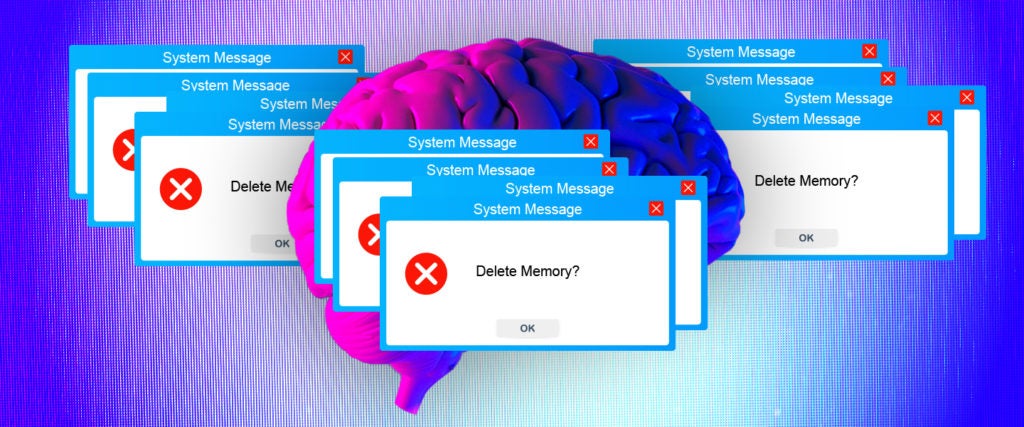I sometimes fantasize about opening my brain and, like a mad scientist, extracting bad memories with a pair of tweezers. The time I waited for hours in a hospital waiting room with my arm bone poking through the skin: pluck. The time I moved states to be with someone, but ended up being alone: pluck. The time I casually waved goodbye to a friend, only to find out that he passed away days later: pluck.
Everyone has memories they wish would go away, and researchers have long been toying with ways of doing so. The task is a daunting one, however. “In my work, we’ve added things to people’s memories,” memory researcher Elizabeth Loftus explains. “We’ve distorted people’s memories. We’ve planted completely false memories. But when we’ve tried to get people to not remember something, it’s a lot harder.”
As research shows, the emotional impact of bad memories makes them much more resistant to the process of decay that all memories experience through time.
Still, researchers have been teasing a pill that promises to make our bad memories better for years. “There’s been some work with a drug called propranolol,” Loftus says. “Supposedly, if you take it soon after you’ve had an awful experience, it can weaken your memory and reduce the chances that you develop post-traumatic stress disorder.”
To understand how propranolol works, it’s important to grasp how memories form and live in our brains. Essentially, they’re a product of proteins triggering brain cells to form new connections. These new connections become memories, and for most of us, revisiting them helps them remain mostly intact over time.
However, like everything else, memories are susceptible to change. For example, when I remember the time I broke my arm and subsequently cringe, I reinforce the connection between that memory and the emotions it provokes, like fear. As a result, I could eventually develop a phobia of breaking bones, which would be more intense than the memory itself. Alternatively, that once-traumatic memory could change to become something I learn to laugh about.
Either way, this process is called reconsolidation, in which memories become malleable as we rethink them.
Researchers believe reconsolidation is where they can step in to potentially sculpt bad memories into something better. For instance, studies show that blocking the chemical norepinephrine, which is involved in our stress response, can dampen memories that provoke unpleasant emotional responses.
This is where propranolol comes in. As a 2013 study concludes, “Propranolol shows promise in reducing subsequent memory for new or recalled emotional material in healthy adults. However, future studies will need to investigate whether more powerful idiosyncratic emotional memories can also be weakened and whether this weakening can bring about long-lasting symptomatic relief in clinical populations, such as patients with post-traumatic stress or other event-related disorders.”
To be clear, the suggestion isn’t that propranolol erases negative memories — it simply reduces the negative emotions they conjure.
There have been more recent studies, but most arrive at the same conclusion: Propranolol could help people separate memories from negative emotions, but we need to be extra careful, because messing with memories can result in some serious unintended side effects. For instance, much science suggests that bad memories play a crucial role in forming us as individuals. They essentially make us who we are.
Of course, that’s not necessarily a good thing. As psychotherapist Erin Wiley explains, “Every negative memory leaves you with a belief about yourself. If you were molested for years by your uncle, you think, ‘I’m used goods. I’m disgusting. I’m a piece of garbage.’ That’s, in fact, what most sexual trauma survivors say. And if you believe you’re garbage or have no value, then you act in ways showing that — like picking partners who treat you like you have no value or who treat you like garbage.”
As such, Wiley suggests a more natural alternative to propranolol — EMDR, or eye movement desensitization and reprocessing. “There are different theories of how it works, but to explain it simply, it involves bimodal stimulation, which is stimulating your body on the left side, then the right side in rhythmic, quick succession,” Wiley explains. “So a therapist could tap you back and forth on each of your knees while you do therapy. You could watch their finger or a pencil go back and forth. You could hold little buzzing tapper things that buzz alternately in your hands. You could put headphones on that have a back-and-forth tone. You’re basically creating a situation that’s almost like REM sleep,” which is important, because REM sleep appears to be involved with our ability to process emotional memories, perhaps by helping us create new connections in our brains.
The outcome of EMDR is similar to that of propranolol: Patients are able to change the negative emotions associated with a memory to something more positive (studies abound about its success). For instance, a victim of molestation could shift from feelings of unworthiness and self-disgust to those of being a strong, brave survivor. “It’s really liberating,” Wiley says.
And while none of this is as immediately effective as plucking bad memories from your brain with tweezers, the end result may be even better.

